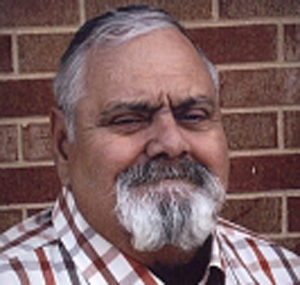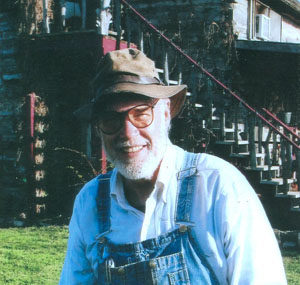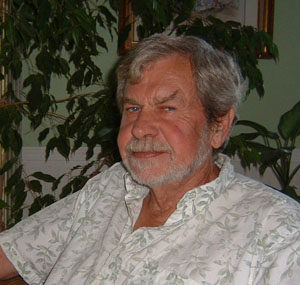M
Leave a Legacy of Giving
You can support our mission of changing lives by saving sight in multiple ways!


Gordon gave the gift of sight to two individuals through the miracle of corneal transplantation.
Like many individuals, Gordon registered to become an eye, organ and tissue donor, but as he got older, he wondered if age and health issues would prevent him from fulfilling his pledge.
However, when he passed away in November 2009, Gordon gave the gift of sight to two individuals through the miracle of corneal transplantation.
Said his wife of 32 years, Mary Jane, “Gordon would joke with us saying, ‘when something happens to me, my parts wouldn’t be of use to anyone.’ When we found out he could be an eye donor, it was such a blessing for our family. It is wonderful to know that my husband and my children’s father lives on through two other people.”
A father to four, grandfather to three and great-grandfather to two, Gordon spent his life helping others. He served in the Vietnam War as a helicopter crew chief before returning to Illinois to work as both a truck driver and a correctional officer. After he retired, Gordon didn’t slow down – he began serving his community as the Mayor of the Village of Harvel, Ill. In his spare time, according to Mary Jane, he enjoyed motorcycle riding, woodworking and gardening.
A few months after Gordon’s death, Mary Jane received a letter from Heartland Lions Eye Banks, sharing the news that his corneas had helped two recipients escape a world of blindness. Mary Jane had long been on the fence about becoming a donor herself, but once she received the stories of her husband’s recipients, she – and her children – made the decision to join Illinois’ donor registry themselves.
“I told my kids their dad helped me make up my mind. Donation is so important. I want to donate anything I can to whoever is in need. Because of Gordon, there is no question in me any longer.”


Recognized throughout the community for his volunteerism, Thomas continued to impact the lives of others after he passed.
Throughout his life, Thomas of Carthage, Mo. took care of his community by donating his time, money and experience to help those in need. It was only fitting after his passing that he continue to improve the lives of others – thanks to Thomas’ pledge to become an eye and tissue donor, he gave the gift of sight to two cornea recipients and helped as many as 50 individuals who benefited from bone and skin grafts.
As an attorney-at-law, father of three and local humanitarian, Thomas played a role in strengthening communities throughout Southwest Missouri. He was instrumental in helping numerous nonprofits in Carthage, Joplin and Neosho get off the ground, and worked as a child advocate through the Court Appointed Special Advocate (CASA) program in Joplin.
Thomas was best known throughout Carthage for using his legal experience to help the underprivileged. Said his wife, Carol Ann, “Thomas was described in the community as a ‘good old country lawyer.’ He went the extra mile and often worked out special deals with those who couldn’t afford legal help. If all someone could afford was $5 a month, that’s what he would charge them.”
Thomas was also an active Missouri Civil War Foundation board of directors member, an avid fisherman and a gardening enthusiast. In fact, his garden was recognized throughout the community, since according to Carol Ann, “Anybody could come by and pick whatever they wanted.”
Knowing Thomas’ caring spirit, it came as no surprise to Carol Ann when Thomas made the pledge to become an eye, organ and tissue donor by signing the back of his driver’s license. After he passed away from a heart attack in 2008, Carol Ann had no reservations regarding the donation decision.
“Donation was what Thomas would have wanted. There was absolutely no hesitation on his part to be a donor. It was his wish, and I was going to honor it. Even though he had cataracts, he was able to donate his corneas to someone in Wisconsin and another person outside the U.S.”
Like the hundreds of lives Thomas impacted each day through his tireless efforts in the Carthage community, dozens of individuals saw their lives improve through his final generous gift – a gift that brings consolation to his wife and those who knew him.
“Understanding that Thomas helped people through his donation was comforting, especially at the beginning,” remarked Carol Ann. “I know he is still able to live on in so many different ways.”
The Carthage Press and The Joplin Globe both ran wonderful articles in December 2010 on Thomas’ life and donation.


After searching for a treatment for his Fuchs’ dystrophy online, Larry and his wife discovered DSAEK.
Five years ago, Larry of Fair Grove, Mo. was diagnosed with Fuchs’ dystrophy, a deterioration of the inner layer of the cornea. While eyeglasses and eye drops helped, his eyesight continued to decline – to the point he could no longer read and had difficulties performing his job as a handyman.
“My sight interfered with my work,” Larry remarked. “I needed an extreme amount of light. I would have to aim a spotlight right on the project to be able to do anything.”
Larry’s optometrist suggested a full cornea transplant to replace his damaged cornea, but the surgery’s long recovery time concerned this active senior. After researching Fuchs’ dystrophy on the Internet, Larry’s wife discovered that normal transplant surgery involved a full year recovery period which would be quite a hardship. Then she happened upon a website for other individuals with Fuchs’ dystrophy to share their experiences. One woman had shared her transplant experience performed by a doctor in Springfield, Mo. who was trained in the latest cornea transplant procedure developed by a doctor in Indiana. Descemet’s stripping automated endothelial keratoplasty (DSAEK) is a 30-minute surgery where only the inner layer of a donated cornea is replaced, requiring fewer sutures, less pain and a shorter recovery time. Larry had found his solution.
In 2008, after undergoing cataracts surgery, Larry underwent his first DSAEK corneal transplant performed by Dr. Shachar Tauber in Springfield, followed by a second surgery one year later. Said Larry, “My overall sight has come back pretty well. I still need glasses to read, but it’s a great improvement. I’m pretty impressed with my surgeries and my recovery.”
Today, Larry, who recently celebrated his 70th birthday, is back to work as a handyman and spends his free time reading and fishing. “My transplant has made life a lot more enjoyable!”


After her corneal transplant surgery, Annie is back to reading and working part-time.
Eyesight is something most of us take for granted – until it is lost. Once vision begins to fade, it can affect all aspect of one’s life – from managing duties at work to simply seeing the face of a friend.
Annie of Jackson, Mo. knows the impact of vision loss first-hand. This married mother of two and grandmother of three began experiencing blurred and hazy vision. She had difficulty reading and was unable to recognize people standing in front of bright light. In May 2009, she was diagnosed with Fuch’s dystrophy, a genetic corneal disease that progressively steals one’s sight, in both of her eyes. Her only option for recovery was a corneal transplant using tissue from an eye donor.
On August 5, 2009, Annie underwent an endothelial keratoplasty on her left eye as an outpatient at St. Francis Medical Center in Cape Girardeau. Said Annie, “Surgery was painless, and the recovery was quick. The only hard part was having to lie flat on my back for 24 hours after surgery, but it was worth it. My eyesight has improved so much!”
Since her surgery, Annie’s blurry vision is gone, and she is back to reading. She can even make out the faces of her friends and family once again. Her improved sight is especially helpful since this retired medical secretary continues to work part-time helping others through Comfort Keepers – an in-home service for the elderly.
Like all transplant recipients through Heartland Lions Eye Banks, Annie was offered the opportunity to correspond with her donor’s family. “When I received the letter, I didn’t know if I wanted to do it. But the more I thought about it, I owed it to the donor’s family – to let them know how much they have helped me and how grateful I was. Since then, I’ve received two letters from the donor’s mother. The first one made me shed a few tears. Her son was a young man who owned his own welding shop. She told me anytime you see a spark in your eye, it’s from my son.”
Annie is very appreciative of her donor’s family as well as Dr. Parker and his entire staff. After seeing the results of surgery and the changes it can bring, she is an avid proponent of eye and tissue donation.
“I’ve always thought about donation, but after going through the surgery, it really has made a believer out of me. I would definitely encourage everyone to register as an eye donor.”


“Now my eyesight is almost normal with a contact on, and playing sports is fun like it used to be. I don’t get looked at weird when people are talking to me, and I don’t have pain any more. Because of my donor, I can finally live my life how I want, without anything bothering me.
The need for a corneal transplant can occur at any age, for a number of reasons. For Kelsie of Kansas it happened in the prime of her young life – just as she was entering her teen years.
Kelsie, an active volleyball and soccer player, began experiencing problems in her eye. After visiting five doctors, she was finally diagnosed with a parasitic amoeba, contracted from contaminated water, such as from a pond of a hot tub. To treat the condition, Kelsie had to take eye drops every hour of the day, but even that didn’t cure the problem.
Said Kelsie, “My condition kept getting worse. It turned into a white blister on my eye, and I could barely see through it. It made playing sports a nightmare.”
Kelsie underwent a sight-saving corneal transplant in to rescue her diminishing vision. Although her recovery is still ongoing, Kelsie was able to get up and about within three days of surgery. Today, as a high school student, Kelsie is back on the playing field – but this time she returns with clear vision. “Now my eyesight is almost normal with a contact on, and playing sports is fun like it used to be. I don’t get looked at weird when people are talking to me, and I don’t have pain anymore. Because of my donor, I can finally live my life how I want, without anything bothering me.”
Kelsie and her family are grateful to her donor family for their generosity in a time of despair. To thank them for their donation, Kelsie, like many Saving Sight cornea recipients, wrote a heartfelt letter to the family.
Kelsie’s mother, Jodie, was especially touched by her daughter’s letter, “Honestly, the worst day of the entire ordeal was the day the nurse was explaining where the donor cornea would come from. It led to some revealing answers for Kelsie – that her donor needed to be near her age. It was very difficult for her to hear that, really for all of us, and I think that’s the day she decided that she wanted to show her appreciation for the generosity of this family that didn’t know her, didn’t know us, but was truly giving her back her life as she knew it.”
Together, Jodie and Kelsie encourage Kansas residents to join the state’s donor registry. “Registering as a donor is the single most selfless thing a person can do,” remarked Jodie. “You can’t imagine the changes and opportunities you can make for someone else in need. I have always been a donor, but it takes on a whole new meaning when someone you love is a recipient.”